The Effect of Bioalcohol Additives on Biofuel Diesel Engines
Abstract
1. Introduction
2. Materials and Methods
2.1. Experimental Equipment
2.2. Development and Validation of the 3D Model
2.2.1. Model Establishment
2.2.2. Mesh Dependency Verification
2.2.3. Model Accuracy Verification
2.3. Sample Preparation
3. Results and Discussion
3.1. Engine Performance
3.1.1. ISFC
3.1.2. ITE
3.2. Combustion Properties
3.2.1. ICP
3.2.2. HRR and ICT
3.3. Emission
3.3.1. NOx
3.3.2. Soot
3.3.3. Hydrocarbon (HC)
3.3.4. CO
4. Conclusions
- Adding both n-butanol and ethanol decreases the ISFC of D70B30 fuel. Specifically, at 25% load, D70B10BU20 achieved a reduction of 1.7% in ISFC. Both ethanol and n-butanol positively impact the increase in ITE, with ethanol showing the most significant effect at full load;
- Alcohol additives play a positive role in reducing NOx emissions under high loads, but the effect is not obvious under low loads. At 75% load, D70B10E20 reduced NOx emissions by 5.56% compared to diesel;
- Alcohol additives effectively reduce soot and HC emissions, particularly at high loads. At 75% load, D70B10E20 achieved a reduction of 17.02% in soot emissions and 46.1% in HC emissions compared to pure diesel;
- Compared to pure diesel, alcohol additives with high oxygen content in blended fuels result in lower CO emissions. Specifically, D70B10BU20 had 16.27% lower CO emissions under a 75% load than diesel fuel.
Author Contributions
Funding
Data Availability Statement
Conflicts of Interest
Nomenclature
| ISFC | Indicated specific fuel consumption | ||
| NOx | Nitrogen oxide | ITE | Indicated Thermal Efficiency |
| CO | Carbon monoxide | ICP | In-Cylinder Pressure |
| ID | Ignition delay | CN | Cetane Number |
| BTE | Brake Thermal Efficiency | LHV | Lower Heating Value |
| BSFC | Brake-Specific Fuel Consumption | ICT | In-cylinder temperature |
| TDC | Top dead center | SOI | Start of Injection |
| CFD | Computational Fluid Dynamics | SOC | Start of Combustion |
| HRR | Heat release rate | HC | Hydrocarbon |
| SO2 | Sulfur dioxide | MDO | Marine Diesel Oil |
| DE | Diesel engine | AMR | Adaptive Mesh Refinement |
References
- Temizer, İ.; Cihan, Ö.; Eskici, B. Numerical and experimental investigation of the effect of biodiesel/diesel fuel on combustion characteristics in CI engine. Fuel 2020, 270, 117523. [Google Scholar] [CrossRef]
- Elkelawy, M.; Kabeel, A.E.; El Shenawy, E.A.; Panchal, H.; Elbanna, A.; Bastawissi, H.A.-E.; Sadasivuni, K.K. Experimental investigation on the influences of acetone organic compound additives into the diesel/biodiesel mixture in CI engine. Sustain. Energy Technol. Assess. 2020, 37, 100614. [Google Scholar] [CrossRef]
- Skalska, K.; Miller, J.S.; Ledakowicz, S. Trends in NOx abatement: A review. Sci. Total Environ. 2010, 408, 3976–3989. [Google Scholar] [CrossRef] [PubMed]
- Malmodin, J.; Bergmark, P. Exploring the effect of ICT solutions on GHG emissions in 2030. In Proceedings of the EnviroInfo and ICT for Sustainability, Copenhagen, Denmark, 7–9 September 2015; pp. 37–46. [Google Scholar]
- Makareviciene, V.; Sendzikiene, E.; Gumbyte, M. Application of simultaneous oil extraction and transesterification in biodiesel fuel synthesis: A review. Energies 2020, 13, 2204. [Google Scholar] [CrossRef]
- Hossain, A.S.; Salleh, A.; Boyce, A.N.; Chowdhury, P.; Naqiuddin, M. Biodiesel fuel production from algae as renewable energy. Am. J. Biochem. 2008, 4, 250–254. [Google Scholar] [CrossRef]
- Shah, Y.R.; Sen, D.J. Bioalcohol as green energy—A review. Int. J. Cur. Sci. Res. 2011, 1, 57–62. [Google Scholar]
- Basha, S.A.; Gopal, K.R.; Jebaraj, S. A review on biodiesel production, combustion, emissions and performance. Renew. Sustain. Energy Rev. 2009, 13, 1628–1634. [Google Scholar] [CrossRef]
- Hasan, M.M.; Rahman, M.M. Performance and emission characteristics of biodiesel–diesel blend and environmental and economic impacts of biodiesel production: A review. Renew. Sustain. Energy Rev. 2017, 74, 938–948. [Google Scholar] [CrossRef]
- K, S.; Alagar, K.; R, V.K.; Vj, M.P.; P, M. Performance and emission characteristics of diesel engine fueled with ternary blends of linseed and rubber seed oil biodiesel. Fuel 2021, 285, 119255. [Google Scholar] [CrossRef]
- Zhong, Y.; Zhang, Y.; Mao, C.; Ukaew, A. Performance, Combustion, and Emission Comparisons of a High-Speed Diesel Engine Fueled with Biodiesel with Different Ethanol Addition Ratios Based on a Combined Kinetic Mechanism. Processes 2022, 10, 1689. [Google Scholar] [CrossRef]
- Abu-Jrai, A.; Yamin, J.A.; Al-Muhtaseb, A.H.; Hararah, M.A. Combustion Characteristics and Engine Emissions of a Diesel Engine Fueled with Diesel and Treated Waste Cooking Oil Blends. Chem. Eng. J. 2011, 172, 129–136. [Google Scholar] [CrossRef]
- Asokan, M.A.; Prabu, S.S. Effect of N-Butanol on Cotton Seed Oil Biodiesel: An Approach for Improving the Emission Behavior of Di Diesel Engine. Pet. Sci. Technol. 2022, 41, 1162–1180. [Google Scholar] [CrossRef]
- Rakopoulos, D.C.; Rakopoulos, C.D.; Hountalas, D.T.; Kakaras, E.C.; Giakoumis, E.G.; Papagiannakis, R.G. Investigation of the performance and emissions of bus engine operating on butanol/diesel fuel blends. Fuel 2010, 89, 2781–2790. [Google Scholar] [CrossRef]
- Wei, L.; Cheung, C.S.; Ning, Z. Effects of biodiesel-ethanol and biodiesel-butanol blends on the combustion, performance and emissions of a diesel engine. Energy 2018, 155, 957–970. [Google Scholar] [CrossRef]
- Rostrup-Nielsen, J.R. Making fuels from biomass. Science 2005, 308, 1421–1422. [Google Scholar] [CrossRef]
- Zhu, L.; Cheung, C.S.; Zhang, W.G.; Huang, Z. Combustion, performance and emission characteristics of a DI diesel engine fueled with ethanol–biodiesel blends. Fuel 2011, 90, 1743–1750. [Google Scholar] [CrossRef]
- Alptekin, E.; Canakci, M.; Ozsezen, A.N.; Turkcan, A.; Sanli, H. Using waste animal fat based biodiesels–bioethanol–diesel fuel blends in a DI diesel engine. Fuel 2015, 157, 245–254. [Google Scholar] [CrossRef]
- Torres-Jimenez, E.; Svoljšak-Jerman, M.; Gregorc, A.; Lisec, I.; Dorado, M.P.; Kegl, B. Physical and chemical properties of ethanol-biodiesel blends for diesel engines. Energy Fuels 2010, 24, 2002–2009. [Google Scholar] [CrossRef]
- Datta, A.; Mandal, B.K. Engine performance, combustion and emission characteristics of a compression ignition engine operating on different biodiesel-alcohol blends. Energy 2017, 125, 470–483. [Google Scholar] [CrossRef]
- Atmanli, A.; Yilmaz, N. An experimental assessment on semi-low temperature combustion using waste oil biodiesel/C3-C5 alcohol blends in a diesel engine. Fuel 2020, 260, 116357. [Google Scholar] [CrossRef]
- Goga, G.; Chauhan, B.S.; Mahla, S.K.; Cho, H.M. Performance and emission characteristics of diesel engine fueled with rice bran biodiesel and n-butanol. Energy Rep. 2019, 5, 78–83. [Google Scholar] [CrossRef]
- Zheng, M.; Li, T.; Han, X. Direct injection of neat n-butanol for enabling clean low temperature combustion in a modern diesel engine. Fuel 2015, 142, 28–37. [Google Scholar] [CrossRef]
- Kattela, S.P.; Vysyaraju, R.K.R.; Surapaneni, S.R.; Ganji, P.R. Effect of n-butanol/diesel blends and piston bowl geometry on combustion and emission characteristics of CI engine. Environ. Sci. Pollut. Res. 2019, 26, 1661–1674. [Google Scholar] [CrossRef] [PubMed]
- Yu, S.; Cao, C.; Lv, W. Combustion and emission characteristics investigation of a marine diesel engine powered by diesel/biodiesel/n-butanol blends. Energy Sci. Eng. 2022, 10, 3317–3330. [Google Scholar] [CrossRef]
- Zhang, Z.; E, J.; Chen, J.; Zhu, H.; Zhao, X.; Han, D.; Zuo, W.; Peng, Q.; Gong, J.; Yin, Z. Effects of low-level water addition on spray, combustion and emission characteristics of a medium speed diesel engine fueled with biodiesel fuel. Fuel 2019, 239, 245–262. [Google Scholar] [CrossRef]
- Han, Z.; Reitz, R.D. Turbulence Modeling of Internal Combustion Engines Using RNG k-ɛ Models. Combust. Sci. Technol. 1995, 106, 267–295. [Google Scholar] [CrossRef]
- Hiroyasu, H.; Kadota, T. Models for combustion and formation of nitric oxide and soot in direct injection diesel engines. SAE Trans. 1976, 85, 513–526. [Google Scholar]
- Nagle, J.; Strickland-Constable, R. Oxidation of Carbon between 1000-2000 °C. Proe. In Proceedings of the Fifth Conference on Carbon; Pergamon: Oxford, UK, 2013; p. 154. [Google Scholar]
- Şener, R.; Nilsen, C.W.; Biles, D.E.; Mueller, C.J. A Computational Investigation of Engine Heat Transfer with Ducted Fuel Injection. Int. J. Engine Res. 2023, 24, 3328–3341. [Google Scholar] [CrossRef]
- Mao, C.; Wei, J.; Wu, X.; Ukaew, A. Performance and Exhaust Emissions from Diesel Engines with Different Blending Ratios of Biofuels. Processes 2024, 12, 501. [Google Scholar] [CrossRef]
- Stagni, A.; Frassoldati, A.; Cuoci, A.; Faravelli, T.; Ranzi, E. Skeletal mechanism reduction through species-targeted sensitivity analysis. Combust. Flame 2016, 163, 382–393. [Google Scholar] [CrossRef]
- Ranzi, E.; Frassoldati, A.; Stagni, A.; Pelucchi, M.; Cuoci, A.; Faravelli, T. Reduced kinetic schemes of complex reaction systems: Fossil and biomass-derived transportation fuels. Int. J. Chem. Kinet. 2014, 46, 512–542. [Google Scholar] [CrossRef]
- Stagni, A.; Cuoci, A.; Frassoldati, A.; Faravelli, T.; Ranzi, E. Lumping and reduction of detailed kinetic schemes: An effective coupling. Ind. Eng. Chem. Res. 2014, 53, 9004–9016. [Google Scholar] [CrossRef]
- Shahabuddin, M.; Liaquat, A.M.; Masjuki, H.H.; Kalam, M.A.; Mofijur, M. Ignition delay, combustion and emission characteristics of diesel engine fueled with biodiesel. Renew. Sustain. Energy Rev. 2013, 21, 623–632. [Google Scholar] [CrossRef]
- Khan, I.A.; Singh, S.; Yadav, A.K.; Ghosh, U.; Sharma, D. Enhancement in the performance of a diesel engine fuelled with Pongamia methyl ester and n-butanol as oxygenated additive. Int. J. Ambient Energy 2019, 40, 842–846. [Google Scholar] [CrossRef]
- Lu, X.; Yang, J.; Zhang, W.; Huang, Z. Effect of cetane number improver on heat release rate and emissions of high speed diesel engine fueled with ethanol–diesel blend fuel. Fuel 2004, 83, 2013–2020. [Google Scholar]
- Rajak, U.; Nashine, P.; Verma, T.N. Characteristics of microalgae spirulina biodiesel with the impact of n-butanol addition on a CI engine. Energy 2019, 189, 116311. [Google Scholar] [CrossRef]
- Atmanli, A. Comparative analyses of diesel–waste oil biodiesel and propanol, n-butanol or 1-pentanol blends in a diesel engine. Fuel 2016, 176, 209–215. [Google Scholar] [CrossRef]
- Nalla, B.T.; Devarajan, Y.; Subbiah, G.; Sharma, D.K.; Krishnamurthy, V.; Mishra, R. Investigations of combustion, performance, and emission characteristics in a diesel engine fueled with Prunus domestica methyl ester and n-butanol blends. Environ. Prog. Sustain. Energy 2022, 41, e13811. [Google Scholar] [CrossRef]
- de Oliveira, A.; de Morais, A.M.; Valente, O.S.; Sodré, J.R. Combustion characteristics, performance and emissions from a diesel power generator fuelled by B7-ethanol blends. Fuel Process. Technol. 2015, 139, 67–72. [Google Scholar] [CrossRef]
- Öztürk, E.; Can, Ö. Effects of EGR, injection retardation and ethanol addition on combustion, performance and emissions of a DI diesel engine fueled with canola biodiesel/diesel fuel blend. Energy 2022, 244, 123129. [Google Scholar] [CrossRef]
- Tat, M.E.; Van Gerpen, J.H.; Soylu, S.; Canakci, M.; Monyem, A.; Wormley, S. The speed of sound and isentropic bulk modulus of biodiesel at 21 C from atmospheric pressure to 35 MPa. J. Am. Oil Chem. Soc. 2000, 77, 285–289. [Google Scholar] [CrossRef]
- Liu, K.; Devarajan, Y.; Nithyanantham, V.; Nalla, B.T.; Krishnamurthy, V. An experimental study on transesterification process and emission analysis of diesel engine propelled with Capparis spinosa biodiesel. Biomass Convers. Biorefinery 2021, 13, 8961–8968. [Google Scholar] [CrossRef]
- Devarajan, Y.; Munuswamy, D.B.; Subbiah, G.; Mishra, R.; Vellaiyan, S. Evaluation of compression ignition engine ignition patterns fueled with dual fuels. Int. J. Green Energy 2022, 19, 676–684. [Google Scholar] [CrossRef]
- Huang, Y.; Li, Y.; Luo, K.; Wang, J. Biodiesel/butanol blends as a pure biofuel excluding fossil fuels: Effects on diesel engine combustion, performance, and emission characteristics. Proc. Inst. Mech. Eng. Part D J. Automob. Eng. 2020, 234, 2988–3000. [Google Scholar] [CrossRef]
- Tsolakis, A. Effects on particle size distribution from the diesel engine operating on RME-biodiesel with EGR. Energy Fuels 2006, 20, 1418–1424. [Google Scholar] [CrossRef]
- Caresana, F. Impact of biodiesel bulk modulus on injection pressure and injection timing. The effect of residual pressure. Fuel 2011, 90, 477–485. [Google Scholar] [CrossRef]
- Doppalapudi, A.; Azad, A.; Khan, M. Advanced strategies to reduce harmful nitrogen-oxide emissions from biodiesel fueled engine. Renew. Sustain. Energy Rev. 2023, 174, 113123. [Google Scholar] [CrossRef]
- Palash, S.; Kalam, M.; Masjuki, H.; Masum, B.; Fattah, I.R.; Mofijur, M. Impacts of biodiesel combustion on NOx emissions and their reduction approaches. Renew. Sustain. Energy Rev. 2013, 23, 473–490. [Google Scholar] [CrossRef]
- Thangaraja, J.; Anand, K.; Mehta, P.S. Biodiesel NOx penalty and control measures-a review. Renew. Sustain. Energy Rev. 2016, 61, 1–24. [Google Scholar] [CrossRef]
- Şener, R. Experimental and Numerical Analysis of a Waste Cooking Oil Biodiesel Blend used in a CI Engine. Int. J. Adv. Eng. Pure Sci. 2021, 33, 299–307. [Google Scholar] [CrossRef]
- Musculus, M.P. Measurements of the influence of soot radiation on in-cylinder temperatures and exhaust NOx in a heavy-duty DI diesel engine. SAE Trans. 2005, 114, 845–866. [Google Scholar]
- Shameer, P.M.; Ramesh, K. Experimental evaluation on performance, combustion behavior and influence of in-cylinder temperature on NOx emission in a DI diesel engine using thermal imager for various alternate fuel blends. Energy 2017, 118, 1334–1344. [Google Scholar] [CrossRef]
- Calam, A.; Solmaz, H.; Yılmaz, E.; İçingür, Y. Investigation of effect of compression ratio on combustion and exhaust emissions in A HCCI engine. Energy 2019, 168, 1208–1216. [Google Scholar] [CrossRef]
- Liu, H.; Ma, J.; Tong, L.; Ma, G.; Zheng, Z.; Yao, M. Investigation on the potential of high efficiency for internal combustion engines. Energies 2018, 11, 513. [Google Scholar] [CrossRef]
- Mathieu, O.; Petersen, E.L. Experimental and modeling study on the high-temperature oxidation of Ammonia and related NOx chemistry. Combust. Flame 2015, 162, 554–570. [Google Scholar] [CrossRef]
- Imtenan, S.; Rahman, S.A.; Masjuki, H.H.; Varman, M.; Kalam, M.A. Effect of dynamic injection pressure on performance, emission and combustion characteristics of a compression ignition engine. Renew. Sustain. Energy Rev. 2015, 52, 1205–1211. [Google Scholar] [CrossRef]
- Prabhu, A.; Venkata Ramanan, M.; Jayaprabakar, J.; Harish, V. Experimental investigation of emission characteristics on ricebran biodiesel–alcohol blends in a diesel engine. Int. J. Ambient Energy 2021, 42, 1123–1128. [Google Scholar] [CrossRef]
- Vedaraman, N.; Puhan, S.; Nagarajan, G.; Velappan, K. Preparation of palm oil biodiesel and effect of various additives on NOx emission reduction in B20: An experimental study. Int. J. Green Energy 2011, 8, 383–397. [Google Scholar] [CrossRef]
- Sathish Kumar, R.; Suresh Kumar, K. Effect of methanol blending with Pongamia pinnata biodiesel and diesel blends on engine performance and exhaust emission characteristics of an unmodified Compression Ignition engine. Int. J. Ambient Energy 2015, 36, 70–75. [Google Scholar] [CrossRef]
- Liu, H.; Bi, X.; Huo, M.; Lee, C.-f.F.; Yao, M. Soot emissions of various oxygenated biofuels in conventional diesel combustion and low-temperature combustion conditions. Energy Fuels 2012, 26, 1900–1911. [Google Scholar] [CrossRef]
- Klein-Douwel, R.J.; Donkerbroek, A.J.; Van Vliet, A.; Boot, M.D.; Somers, L.; Baert, R.; Dam, N.; Ter Meulen, J. Soot and chemiluminescence in diesel combustion of bio-derived, oxygenated and reference fuels. Proc. Combust. Inst. 2009, 32, 2817–2825. [Google Scholar] [CrossRef]
- Boot, M.; Frijters, P.; Luijten, C.; Somers, B.; Baert, R.; Donkerbroek, A.; Klein-Douwel, R.J.; Dam, N. Cyclic oxygenates: A new class of second-generation biofuels for diesel engines? Energy Fuels 2009, 23, 1808–1817. [Google Scholar] [CrossRef]
- Kumar, B.R.; Saravanan, S.; Rana, D.; Nagendran, A. A comparative analysis on combustion and emissions of some next generation higher-alcohol/diesel blends in a direct-injection diesel engine. Energy Convers. Manag. 2016, 119, 246–256. [Google Scholar] [CrossRef]
- Beyaz, M.; Aydın, S.; Şener, R.; Sayin, C. Effects of ethyl proxitol (1-ethoxy-2-propanol) additive on combustion and emission characteristics of biodiesel blends. Biofuels 2023, 14, 817–824. [Google Scholar] [CrossRef]
- Zhou, X.; Qian, W.; Pan, M.; Huang, R.; Xu, L.; Yin, J. Potential of n-butanol/diesel blends for CI engines under post injection strategy and different EGR rates conditions. Energy Convers. Manag. 2020, 204, 112329. [Google Scholar] [CrossRef]
- Yilmaz, N.; Vigil, F.M.; Atmanli, A.; Donaldson, B. Detailed analysis of PAH formation, toxicity and regulated pollutants in a diesel engine running on diesel blends with n-propanol, n-butanol and n-pentanol. Energies 2022, 15, 6487. [Google Scholar] [CrossRef]
- Pan, M.; Tong, C.; Qian, W.; Lu, F.; Yin, J.; Huang, H. The effect of butanol isomers on diesel engine performance, emission and combustion characteristics under different load conditions. Fuel 2020, 277, 118188. [Google Scholar] [CrossRef]
- Jamrozik, A.; Tutak, W. Alcohols as Biofuel for a Diesel Engine with Blend Mode—A Review. Energies 2024, 17, 4516. [Google Scholar] [CrossRef]
- Aydin, H.; Bayindir, H. Performance and emission analysis of cottonseed oil methyl ester in a diesel engine. Renew. Energy 2010, 35, 588–592. [Google Scholar] [CrossRef]
- Karabektas, M. The effects of turbocharger on the performance and exhaust emissions of a diesel engine fuelled with biodiesel. Renew. Energy 2009, 34, 989–993. [Google Scholar] [CrossRef]
- Carraretto, C.; Macor, A.; Mirandola, A.; Stoppato, A.; Tonon, S. Biodiesel as alternative fuel: Experimental analysis and energetic evaluations. Energy 2004, 29, 2195–2211. [Google Scholar] [CrossRef]
- Ulusoy, Y.; Tekin, Y.; Cetinkaya, M.; Karaosmanoglu, F. The engine tests of biodiesel from used frying oil. Energy Sources 2004, 26, 927–932. [Google Scholar] [CrossRef]
- Meng, X.; Chen, G.; Wang, Y. Biodiesel production from waste cooking oil via alkali catalyst and its engine test. Fuel Process. Technol. 2008, 89, 851–857. [Google Scholar] [CrossRef]
- Bhale, P.V.; Deshpande, N.V.; Thombre, S.B. Improving the low temperature properties of biodiesel fuel. Renew. Energy 2009, 34, 794–800. [Google Scholar] [CrossRef]
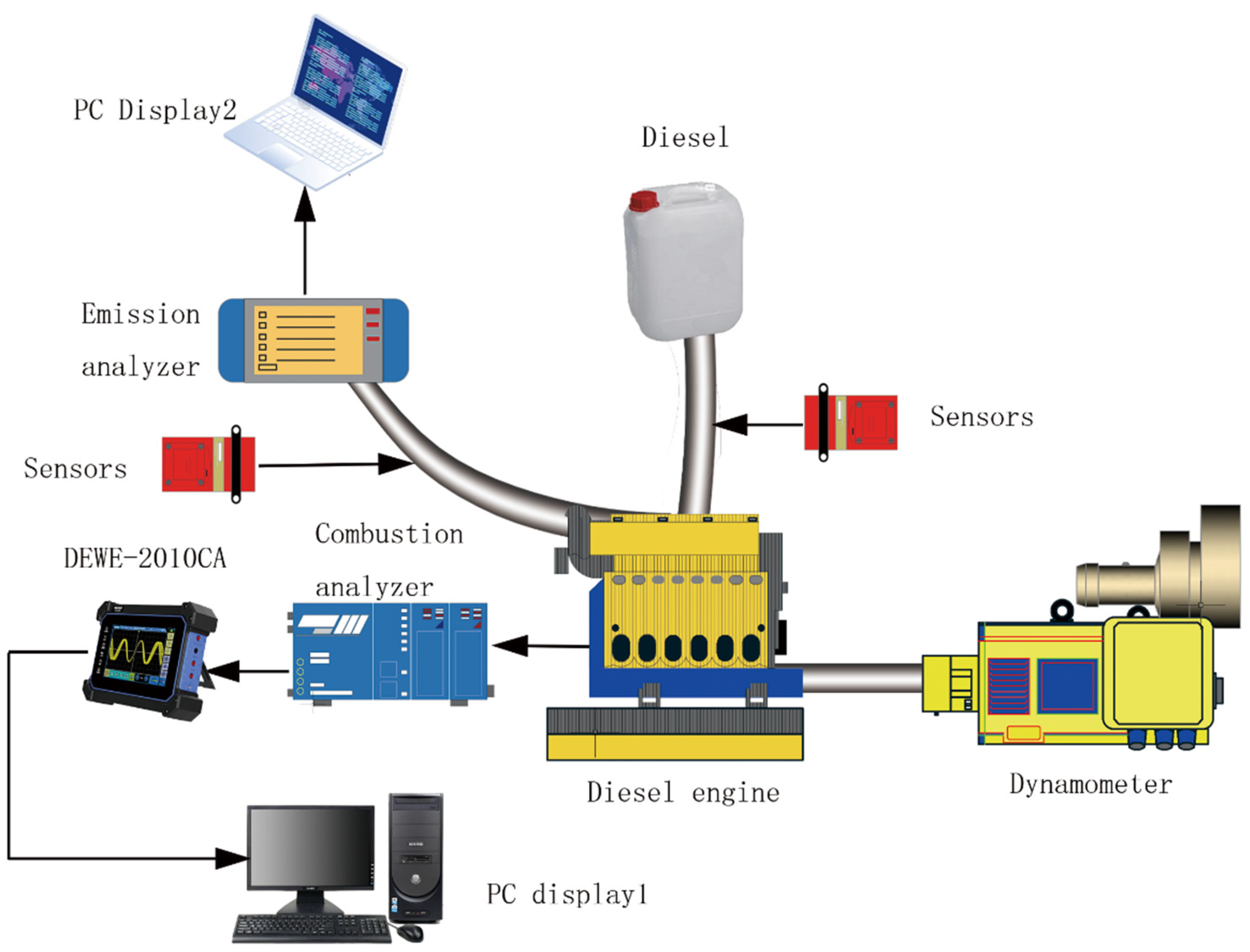


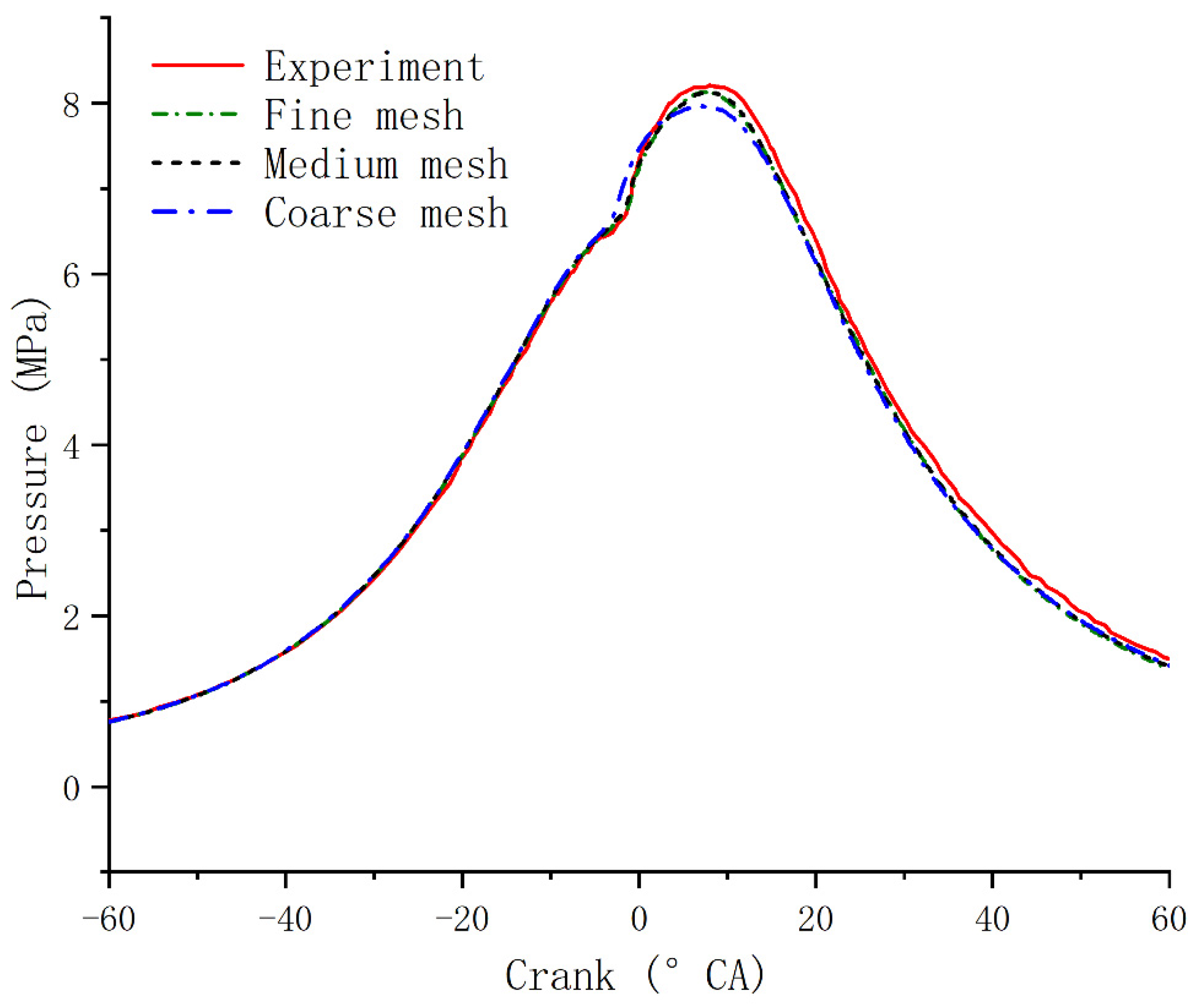
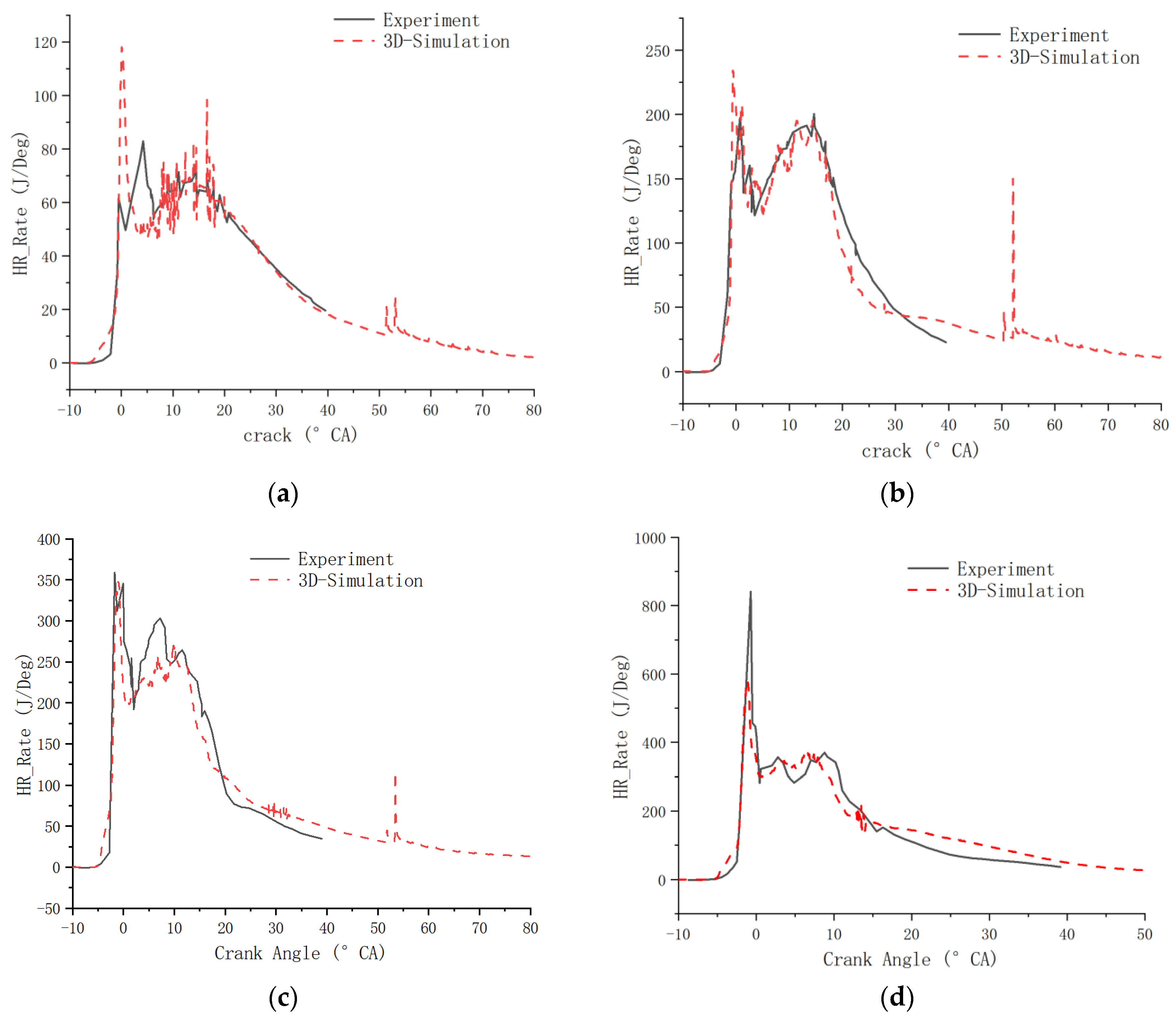


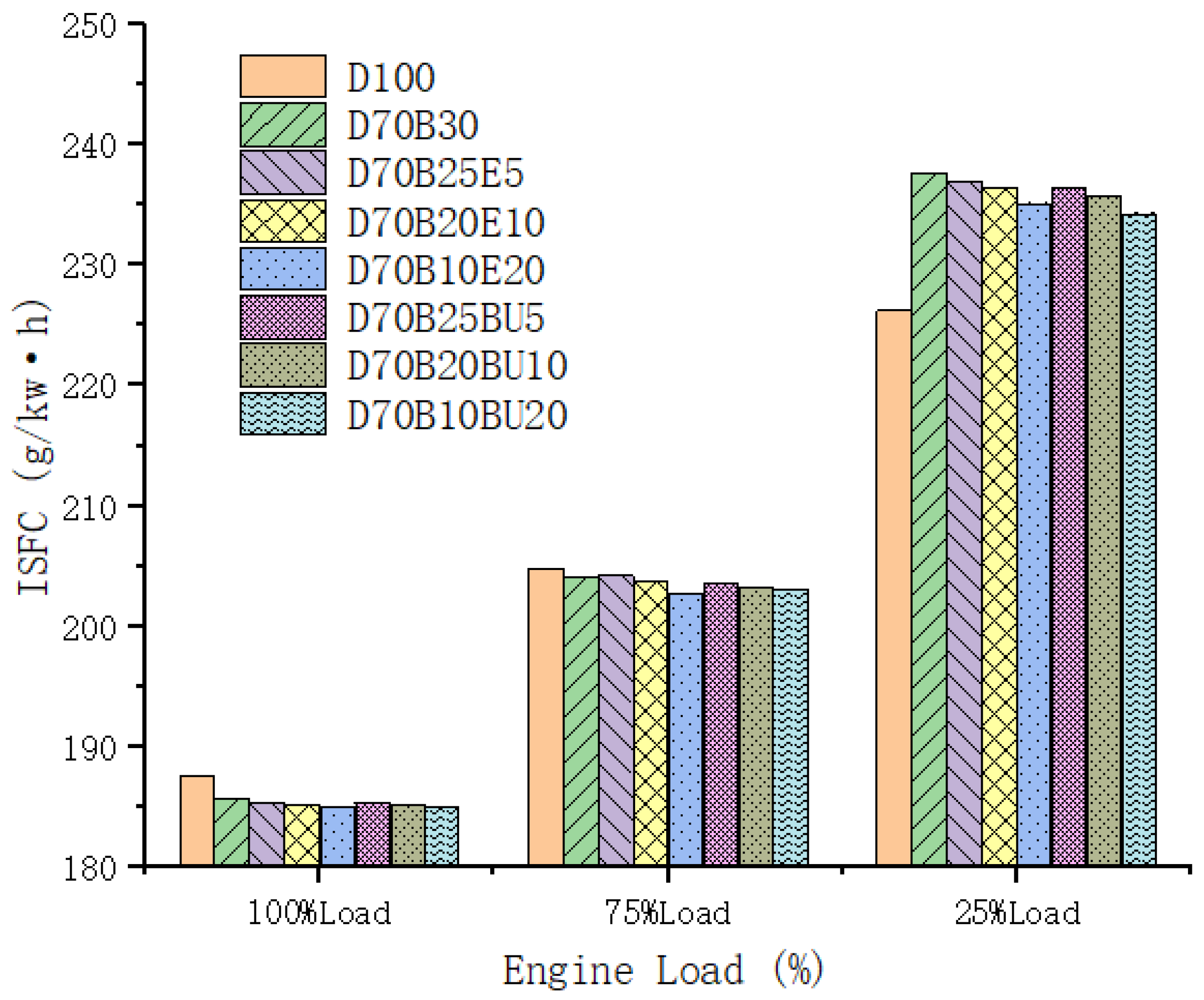


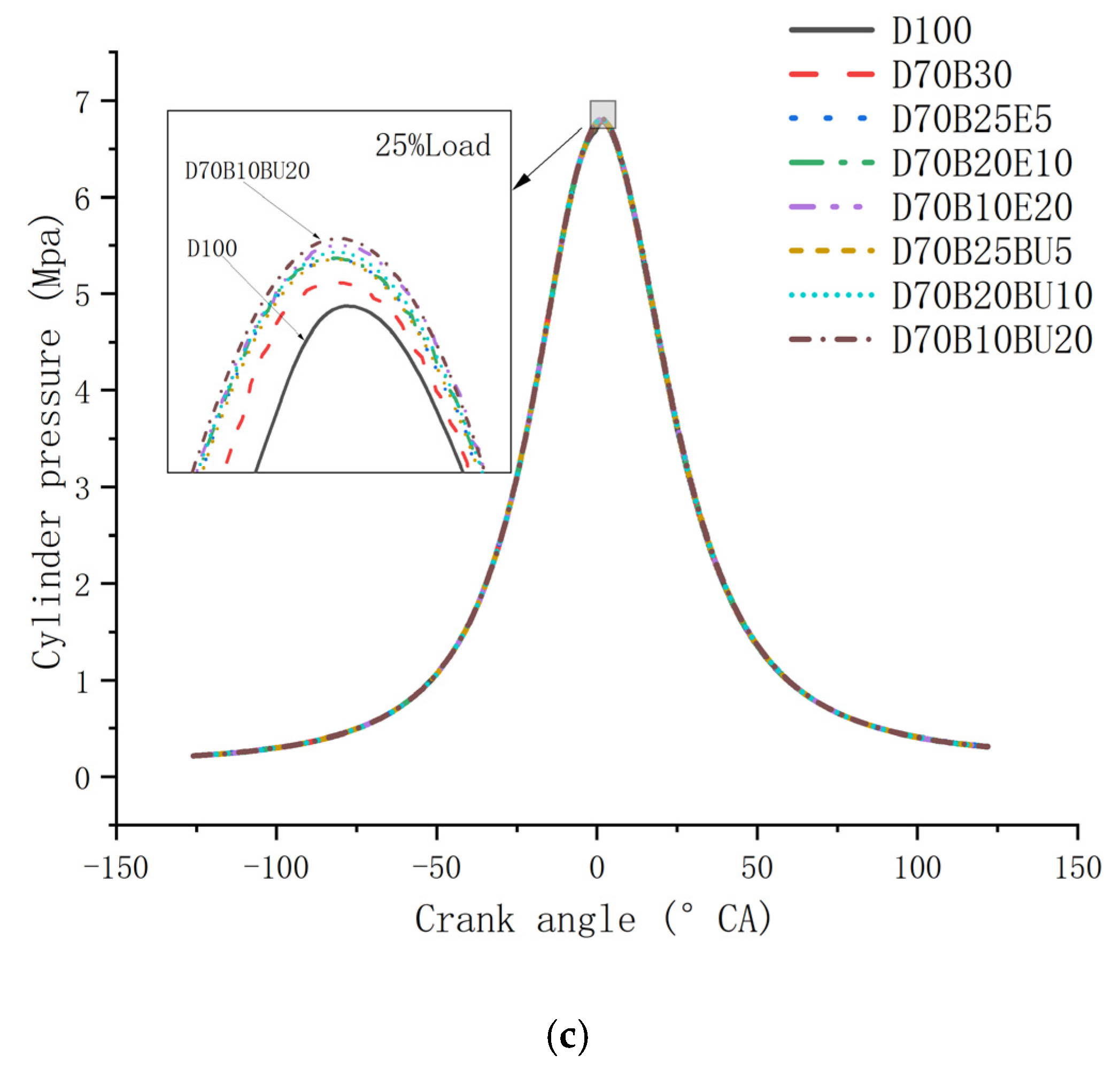
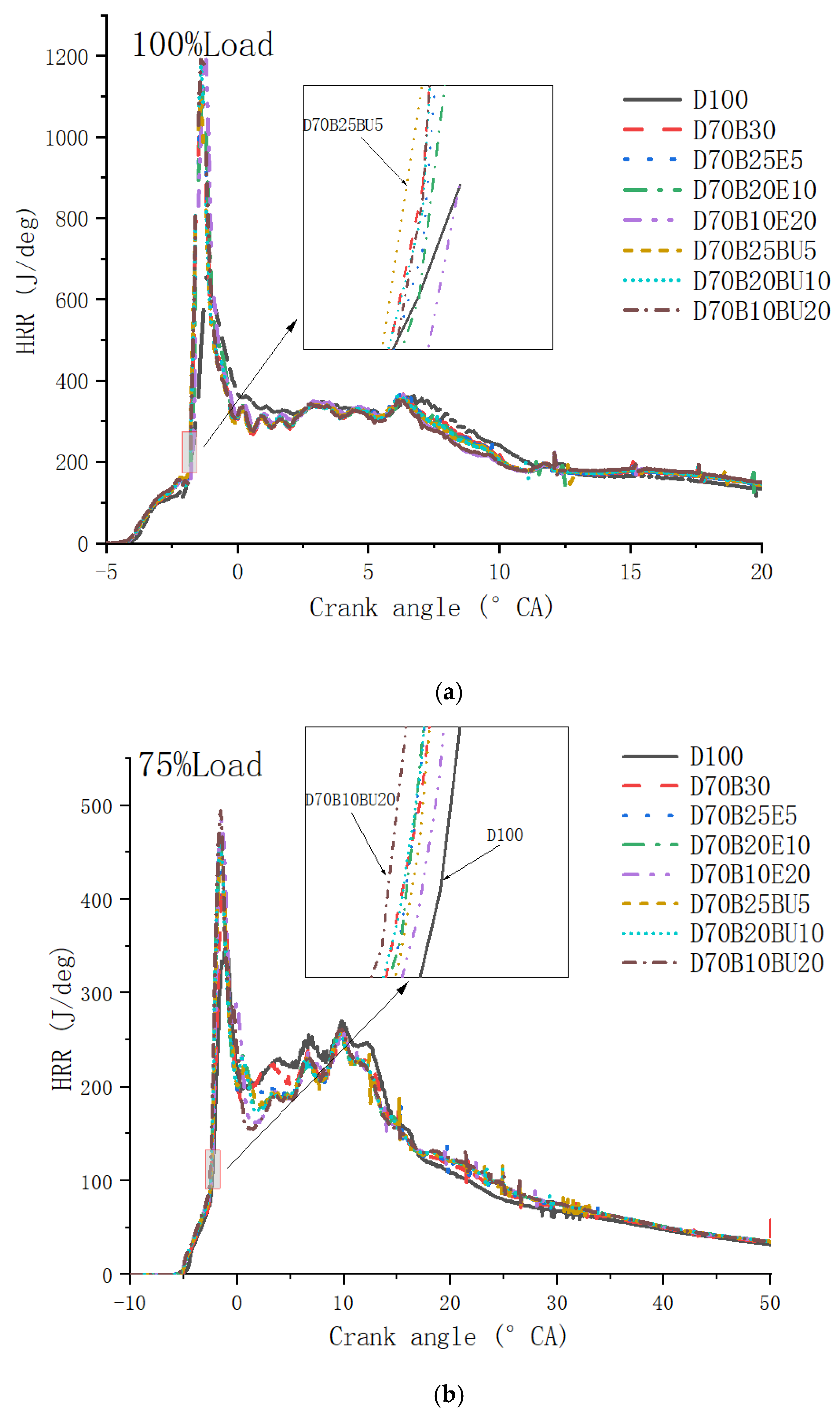


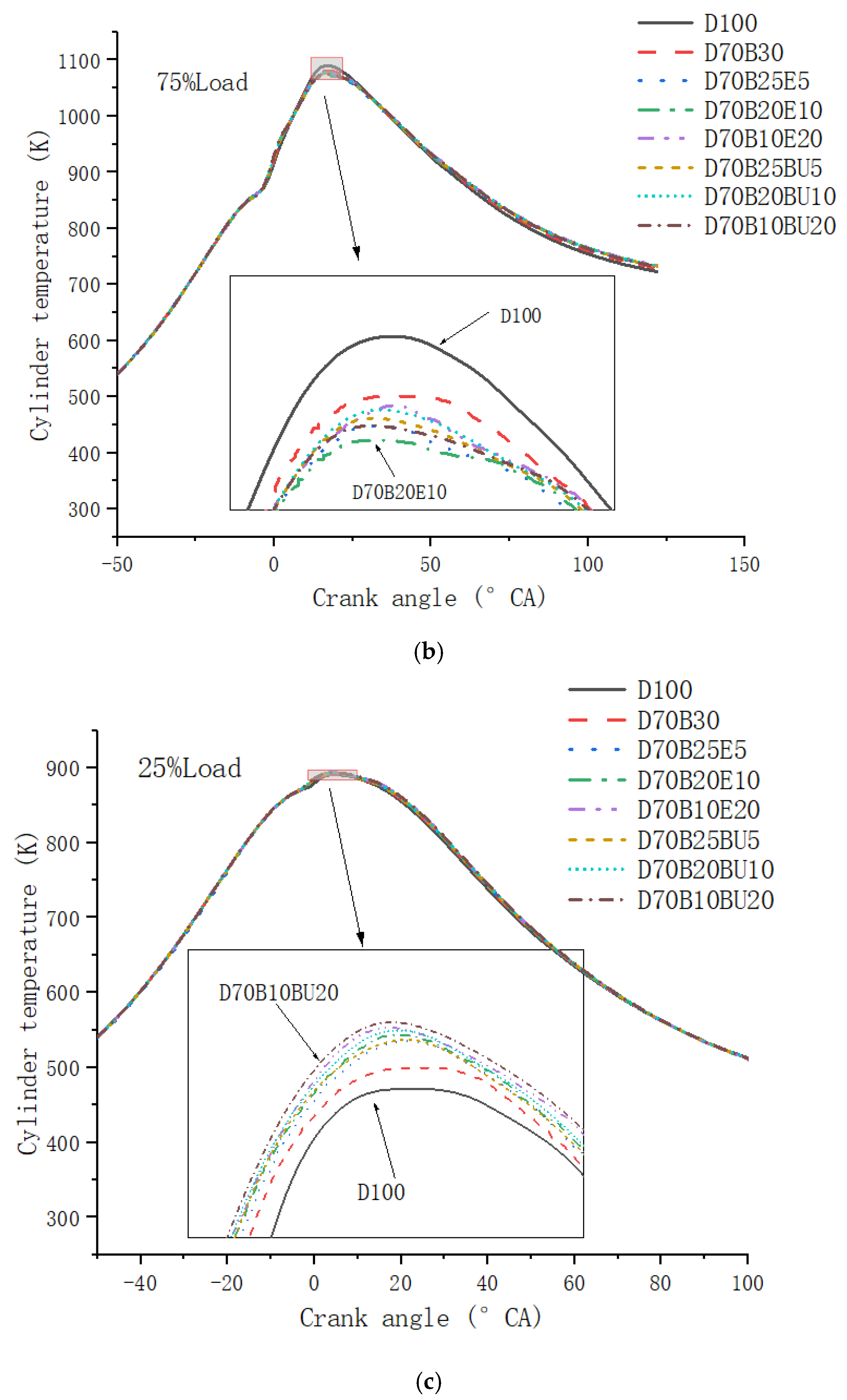

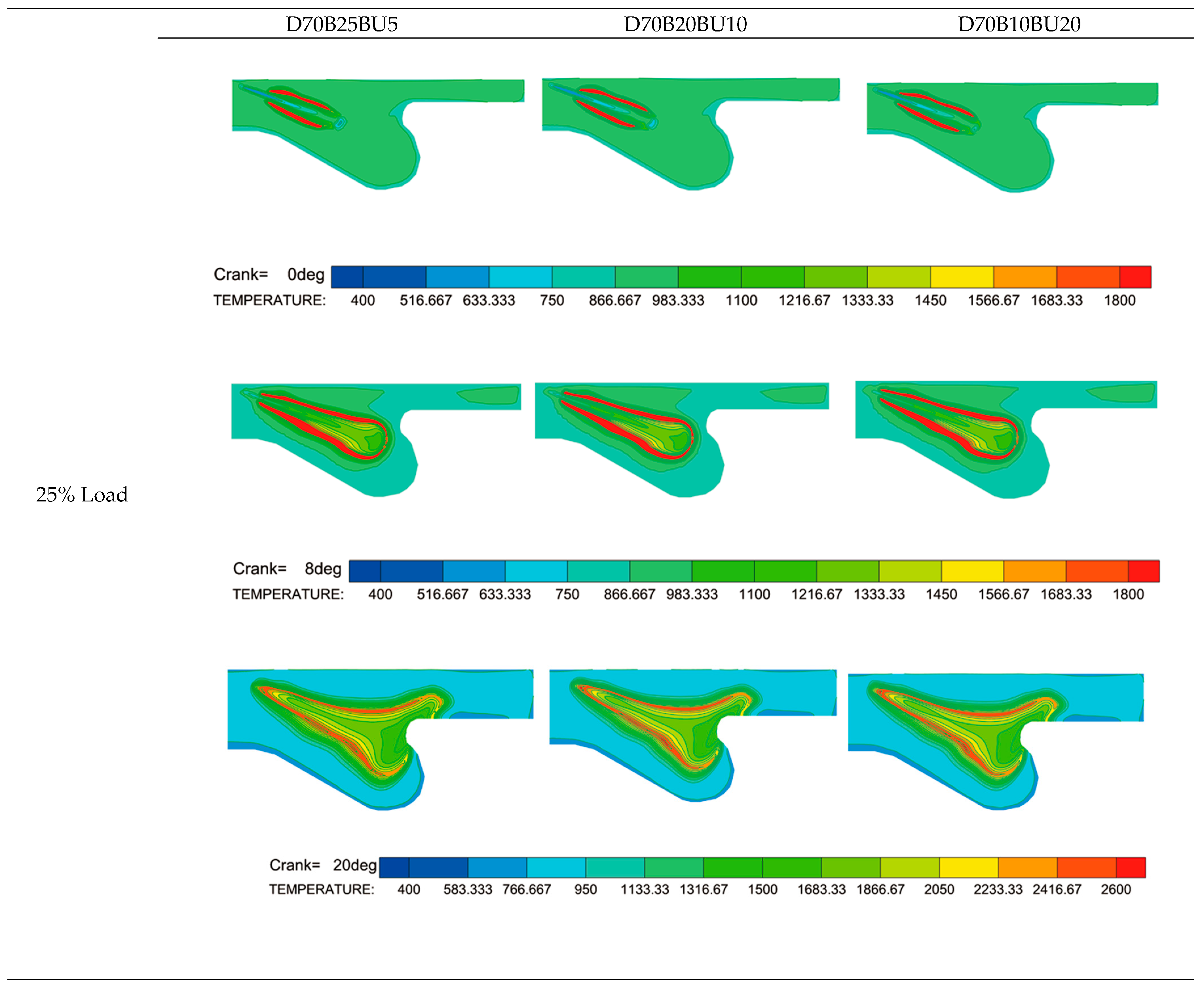


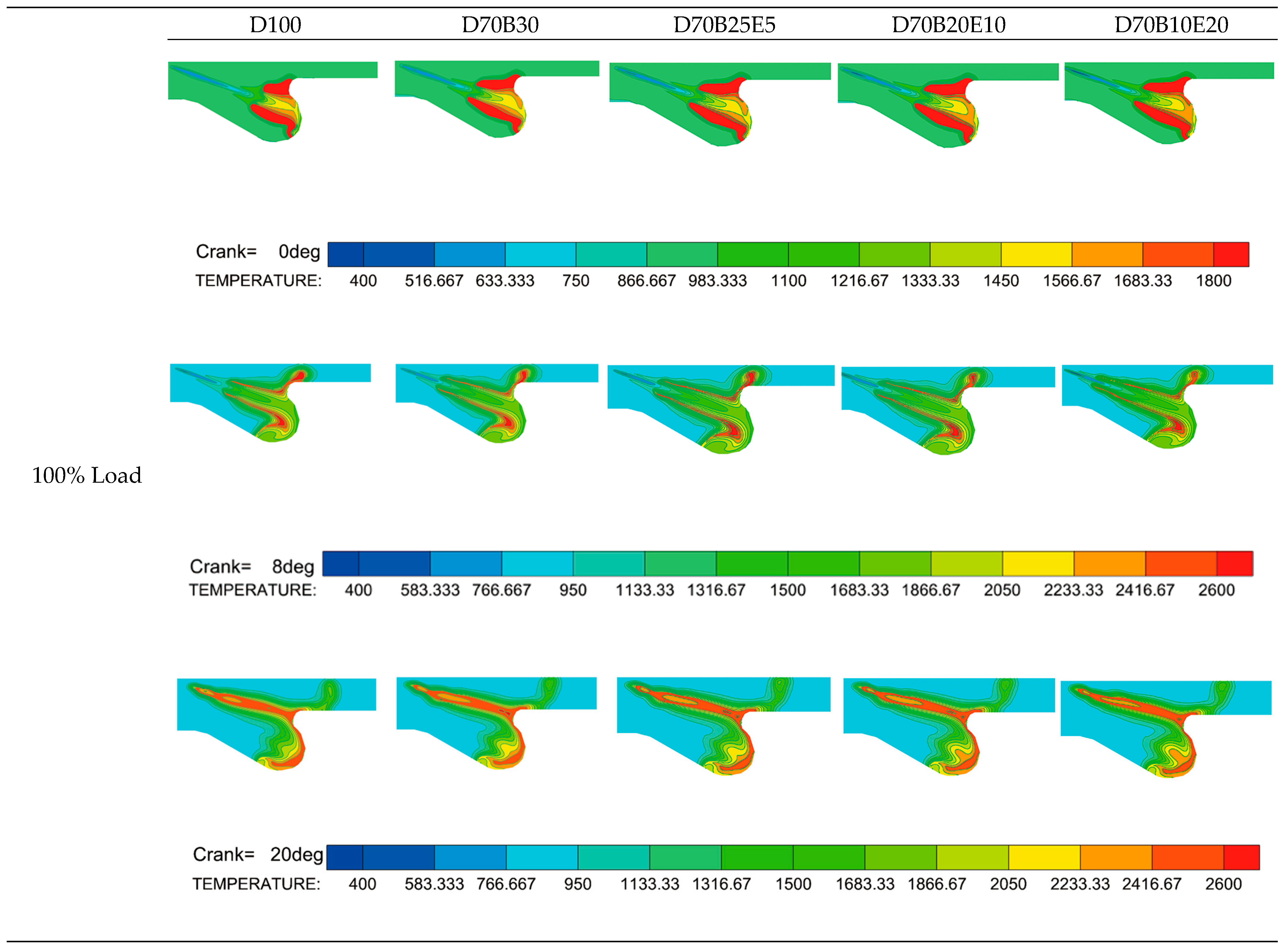

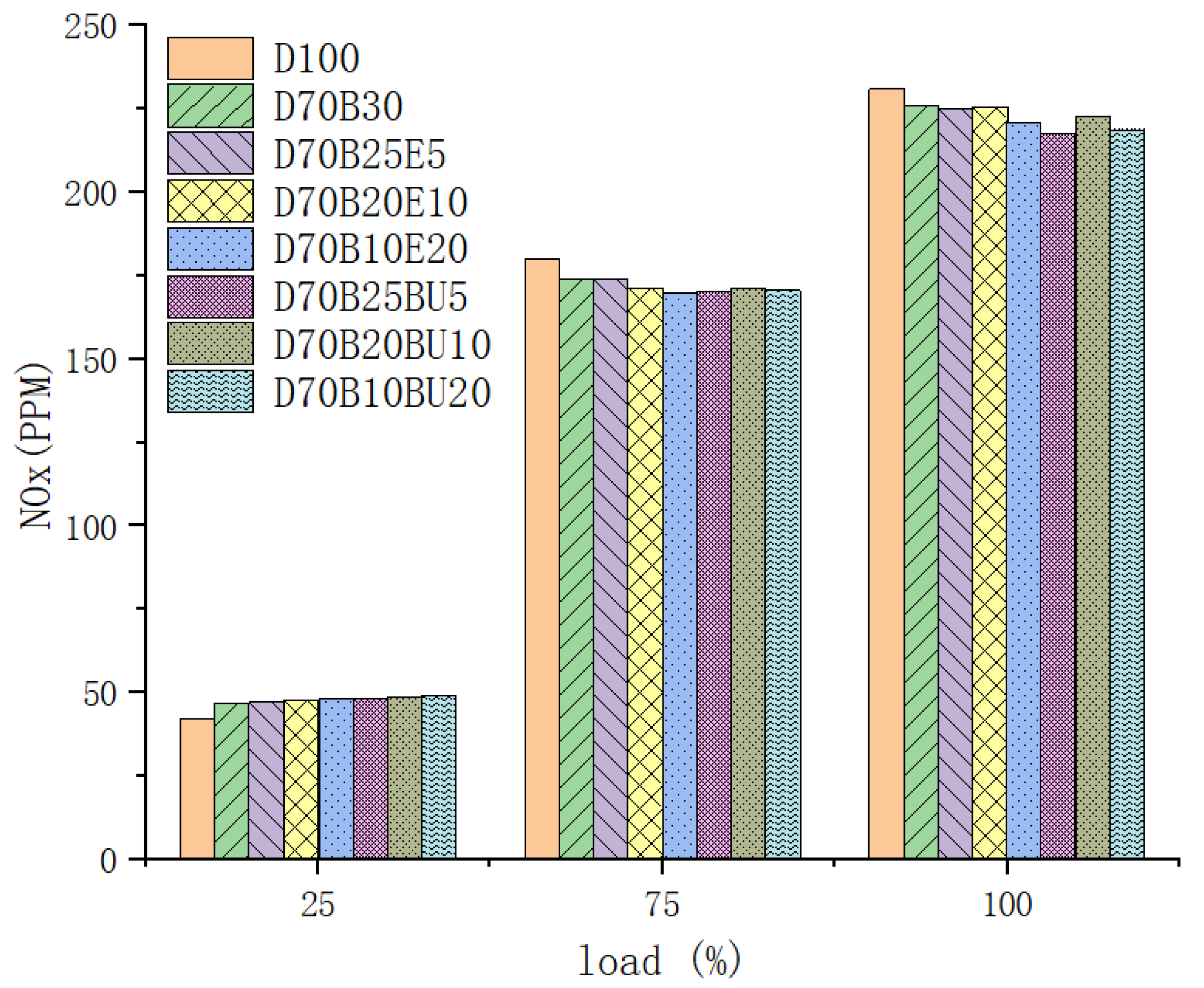
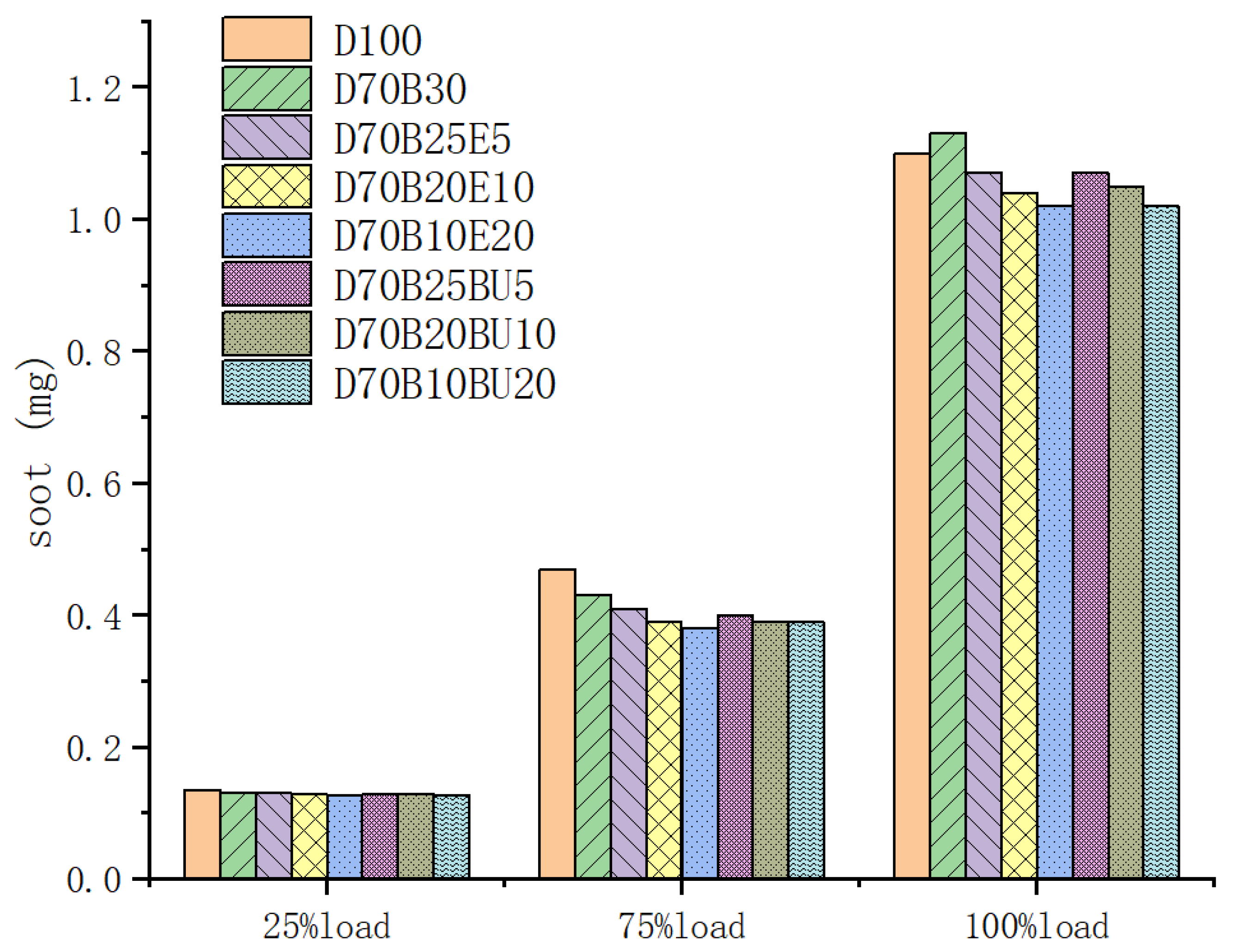
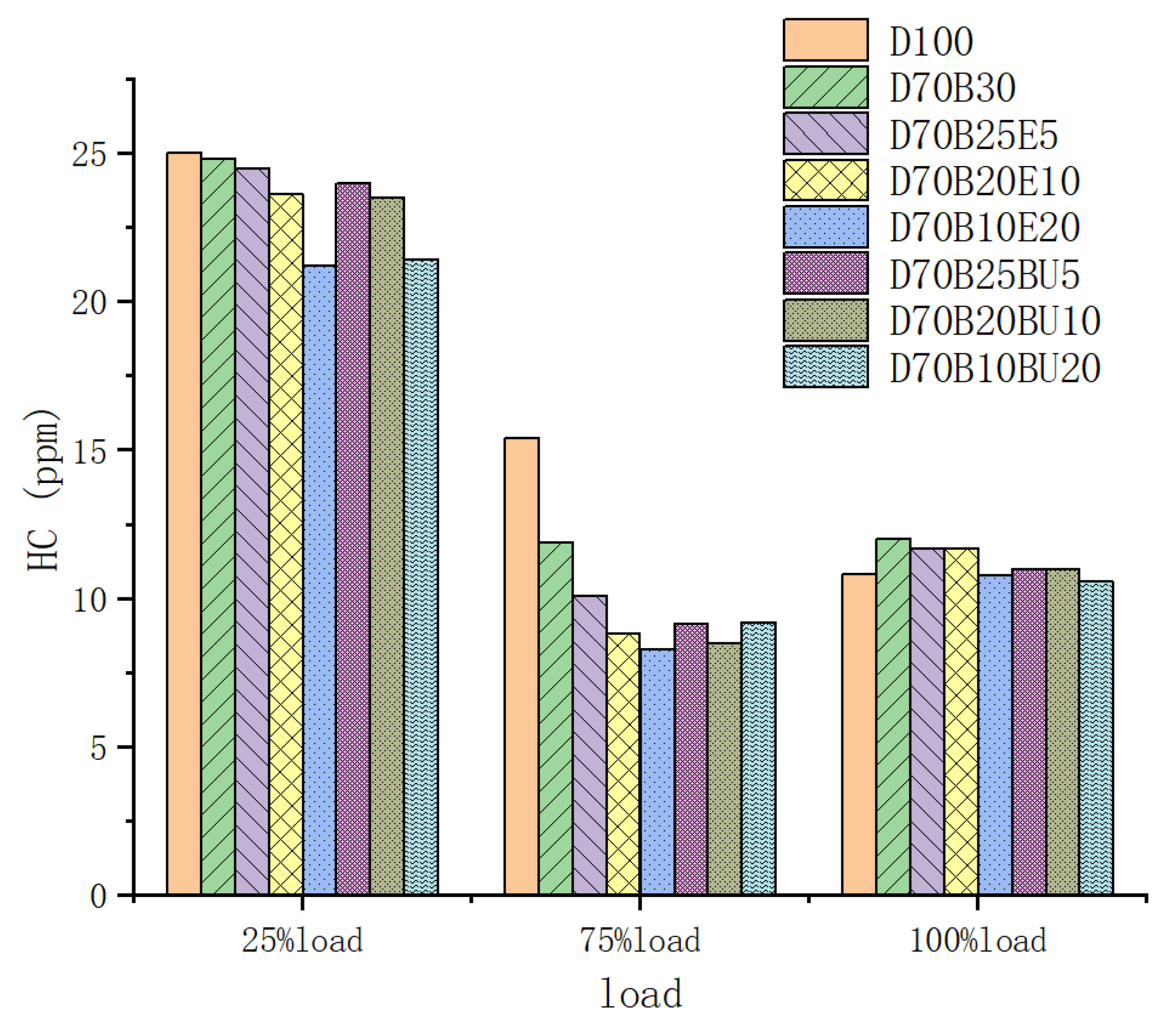
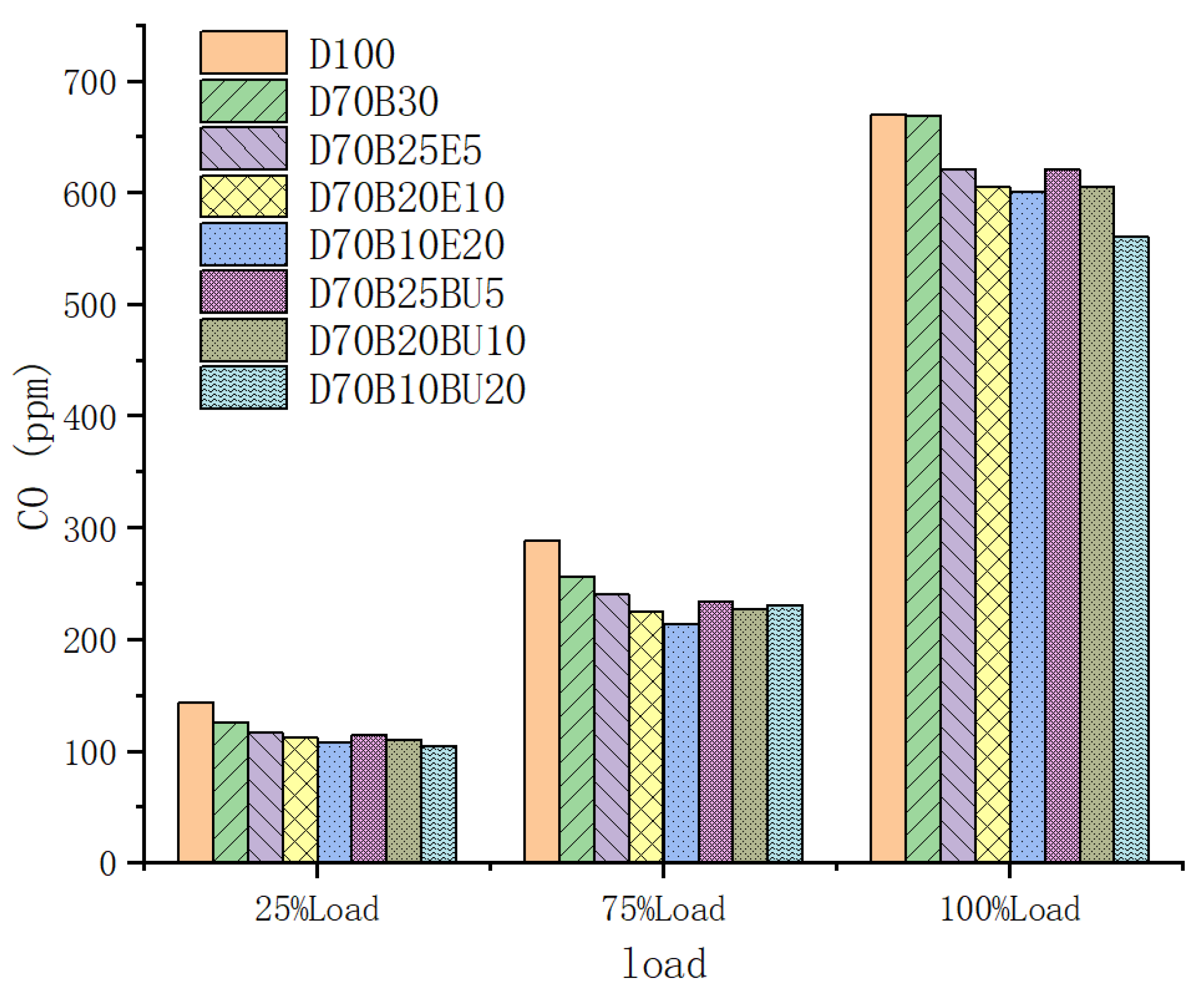
| Code | Measured Quantity | Content/Measurement Range | Accuracy | Unit | Uncertainty (%) |
|---|---|---|---|---|---|
| P | Pressure | 0–25 | ±0.01 | MPa | ±0.5 |
| C | CO emission | 0–10 | ±0.03 | % vol | ±0.32 |
| E | Exhaust gas temperature | 0–1000 | ±1% (FS) | °C | ±0.25 |
| B | Brake power | - | 0.03 | kw | ±0.03 |
| N | NOx emission | 0–5000 | ±10 | ppm | ±0.53 |
| S | Soot emission | 0–9 | ±0.1 | FSN | ±2.8 |
| H | HC emission | 0–20,000 | ±10 | ppm | ±0.11 |
| A | Air flow mass | 0–33,300 | ±1% (FS) | g/min | ±0.5 |
| ES | Engine speed | 1–2000 | ±0.2% (FS) | rpm | ±0.24 |
| F | Fuel flow measurement | 0.5–100 | ±0.04 | L/h | ±0.5 |
| Performance Parameter | Measure | Measurement |
|---|---|---|
| Engine type | - | Four-cylinder, turbocharged, water cooling |
| Cylinder count | - | 4 |
| Nozzle opening size | mm | 0.26 |
| Bore and stroke dimensions | mm | 190 × 210 |
| Conrod | m | 0.410 |
| Revolutions speed | rpm | 2000 |
| Injection nozzles | - | 8 |
| Power rating | kW | 220 |
| No. | Fuel Name | Composition |
|---|---|---|
| 1. | D100 | 100% diesel |
| 2. | D70B25BU5 | 70% diesel + 25% biodiesel + 5%N-butanol |
| 3. | D70B20BU10 | 70% diesel + 20% biodiesel + 10% N-butanol |
| 4. | D70B10BU20 | 70% diesel + 10% biodiesel + 20% N-butanol |
| 5. | D70B25E5 | 70% diesel + 25% biodiesel + 5% Ethanol |
| 6. | D70B20E10 | 70% diesel + 20% biodiesel + 10% Ethanol |
| 7. | D70B10E20 | 70% diesel + 10% biodiesel + 20% Ethanol |
| 8. | D70B30 | 70% diesel + 30% biodiesel |
| Property | Biodiesel [35] | Ethanol | Diesel | n-Butanol [11] |
|---|---|---|---|---|
| Density (g/mL, at 293.15 K) | 0.871 | 0.786 | 0.835–0.837 | 0.81 |
| Evaporation heat (kJ/kg) | 300 | 840 | 260 | 585.6 |
| Cetane number (CN) | 53 | 6 | 45–51 | 25 |
| Lower Heating Value (LHV)(J/g) | 37,500 | 28,400 | 42,500 | 30,630 |
| Viscousness (mm2/s, at 293.15 K) | 5.28 | 1.2 | 2.72 | 2.22 |
| Air–fuel ratio | 12.5 | 9 | 14.3 | 11.21 |
| Boiling temperature (°C) | 240–340 | 78.3 | 210–235 | 118 |
| Oxygen volume fraction (%) | 10.8 | 34.8 | 0.0 | 21.6 |
| Blend | Oxygen Volume Fraction (%) | Density (g/mL, at 293.15 K) | CN | Stoichiometric Air–Fuel Ratio | Evaporation Heat (kJ/kg) | Viscosity (mm2/s, at 20 °C) | LHV (J/g) |
|---|---|---|---|---|---|---|---|
| D100 | 0 | 0.836 | 48.0 | 14.30 | 260 | 2.720 | 42,500 |
| D70B30 | 3.24 | 0.847 | 49.5 | 13.76 | 272 | 3.488 | 41,000 |
| D70B10E20 | 8.04 | 0.848 | 40.1 | 13.06 | 380 | 2.672 | 39,180 |
| D70B20E10 | 5.64 | 0.847 | 44.8 | 13.41 | 326 | 3.080 | 40,090 |
| D70B25E5 | 4.44 | 0.847 | 47.12 | 13.59 | 299 | 3.284 | 40,545 |
| D70B10Bu20 | 5.4 | 0.834 | 43.9 | 13.50 | 329 | 2.876 | 39,626 |
| D70B20Bu10 | 4.32 | 0.840 | 46.7 | 13.63 | 300 | 3.182 | 40,313 |
| D70B25Bu5 | 3.78 | 0.843 | 48.1 | 13.70 | 286 | 3.335 | 40,657 |
Disclaimer/Publisher’s Note: The statements, opinions and data contained in all publications are solely those of the individual author(s) and contributor(s) and not of MDPI and/or the editor(s). MDPI and/or the editor(s) disclaim responsibility for any injury to people or property resulting from any ideas, methods, instructions or products referred to in the content. |
© 2024 by the authors. Licensee MDPI, Basel, Switzerland. This article is an open access article distributed under the terms and conditions of the Creative Commons Attribution (CC BY) license (https://creativecommons.org/licenses/by/4.0/).
Share and Cite
Mao, C.; Wei, J.; Lan, W.; Ukaew, A. The Effect of Bioalcohol Additives on Biofuel Diesel Engines. Fire 2024, 7, 404. https://doi.org/10.3390/fire7110404
Mao C, Wei J, Lan W, Ukaew A. The Effect of Bioalcohol Additives on Biofuel Diesel Engines. Fire. 2024; 7(11):404. https://doi.org/10.3390/fire7110404
Chicago/Turabian StyleMao, Chengfang, Jiewen Wei, Wangsheng Lan, and Ananchai Ukaew. 2024. "The Effect of Bioalcohol Additives on Biofuel Diesel Engines" Fire 7, no. 11: 404. https://doi.org/10.3390/fire7110404
APA StyleMao, C., Wei, J., Lan, W., & Ukaew, A. (2024). The Effect of Bioalcohol Additives on Biofuel Diesel Engines. Fire, 7(11), 404. https://doi.org/10.3390/fire7110404






